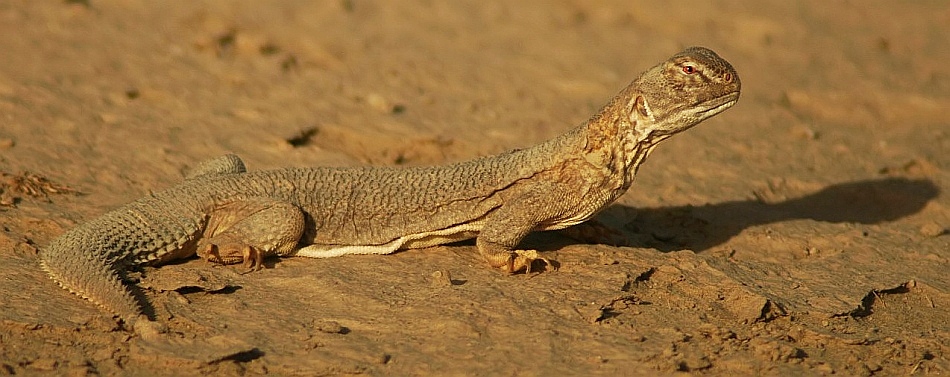Post by Ceratodromeus on Jan 5, 2016 23:58:01 GMT 5

Scientific classification
Kingdom: Animalia
Phylum: Chordata
Subphylum: Vertebrata
Class: Reptilia
Order: Squamata
Suborder: Iguania
Family: Agamidae
Genus: Saara
Species: Saara hardwickii
Description
This is a large species of desert dwelling agamid, with a body coloration that is predominately mottled yellow and black or brown, but some animals in different locales are more lightly colored. The belly is white, Darker colored individuals, with almost entirely black dorsal coloration, do exist however. The head is short and rounded, and the body is slightly compressed; this helps them squeeze into rock crevices. Like the common name indicates, the tail is covered in short spines, and the tail can be automotized if the animal feels threatened. Sexually mature animals range any where from 15-43cm(5.9-16.9in) in total body length{1,2}. The species was put in the resurrected genus Saara after studies conducted in 2008 concluded that it did not belong in the lumping genus Uromastyx{2}.

Geographic range
This species can be found in the deserts by the Border of India and Pakistan.They craft long, distinct burrows and spend large amounts of time in them. These animals are most active in the earlier parts of the day, and can be commonly found foraging at these times. as temperatures rise, the lizards return to their burrows. Other refuges noted to be used by the Indian spiny tailed lizard include herbacious cover( particularly tall clumps of grasses)and large rocks. Indian spiny tailed lizards utilize a thermoregulation technique that allows them to absorb heat even in cooler temperatures; their body coloration becomes darker as they on large rocks with temperatures are cooler.

Dietary habits
As adults they are nearly entirely herbivorous, when it's available, they feed primarily on the common purslane(Portulaca quadrifida), but will normally graze on an assortment of grasses in their environment. Plant species ingested by the species include the shrubby sea-blite (Suaeda fruticosa), Punarnava (Boerhavia diffusa), and nut sedge(Cyperus rotundus).Young animals eat far more insects then their adult counterparts (insect ingestion is thought to be secondary on the part of the latter), feeding on moths, catepillars, beetles, and spiders{3}. Juveniles go through an ontogenic change in dentition, and subsequently diet, as they reach maturity.
Reproduction
These lizards breed after emerging from hibernation, and the period in which they mate is figured to be February-April. Young animals emerge from the adult females' burrow, and can number as many as 16, hinting at a large clutch size{4}. The young measure 5-9cm(1.9-3.5in) in total body length {1} , and become independent after approximately a month when they begin constructing their own burrows. Like the adults, juvenile animals are vulnerable to predation from monitor lizards, foxes, and raptorial birds.

References
{1} Hashmi, M. Usman Ali, and M. Zaheer Khan. "Observation of the Status, Distribution, Habitat and Population Estimation of the Indian Spiny Tailed Lizard Saara hardwickii (Gray, 1827) of Thatta District of Sindh Pakistan." American Journal of Zoological Research 2.3 (2014): 46-50.
{2} Wilms, Thomas M., et al. "On the phylogeny and taxonomy of the genus Uromastyx Merrem, 1820 (Reptilia: Squamata: Agamidae: Uromastycinae)—resurrection of the genus Saara Gray, 1845." Bonner zoologische Beiträge 56 (2009): 55-99.
{3} Das, Sanjay K., et al. "Ecological observations on the Indian Spiny-tailed Lizard Saara hardwickii (Gray, 1827)(Reptilia: Squamata: Agamidae) in Tal Chhapar Wildlife Sanctuary, Rajasthan, India." Journal of Threatened Taxa 5.1 (2013): 3516-3526.
{4} Ramesh, Madhuri, and Ravi Sankaran. "Natural History Observations on the Indian Spiny-tailed Lizard Uromastyx hardwickii in the Thar Desert." Faunal Heritage of Rajasthan, India. Springer New York, 2013. 295-310.


